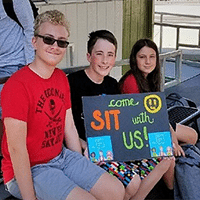 View Winners →
View Winners → San Gabriel Valley Schools Adopt Anti-Bullying Program


Duarte High School students took the pledge to stand up against bullying. Courtesy Photo
By May S. Ruiz
Bullying is a common occurrence in schools and the numbers prove it; one study revealed that as many as 49 percent of children in grades 4-12 have been bullied at least once during the past month.
School administrators and teachers have been looking for ways to solve this prevalent problem. For years several different methods to stop bullying have been utilized, including zero tolerance and expulsion which have since been deemed ineffective.
Several schools in the San Gabriel Valley are grabbing this bull by the horns, so to speak, through active and ongoing conversations with students and parents about bullying. One independent school in Arcadia went a step further by including a social curriculum to create acceptable standards of behavior on campus.
This challenge is front and center in the Duarte Unified School District (DUSD) where Superintendent, Allan Mucerino, is taking a PBIS (Positive Behavioral Interventions and Supports) approach to teasing and bullying in the classroom.
States Mucerino, “PBIS has been quite popular in Orange County where I came from before it made its way to Los Angeles in the last five to six years. I brought it to my last district when I came to Los Angeles prior to landing in Duarte, and it has grown by leaps and bounds. It’s a school-wide behavior management system with social emotional learning embedded into the program. The key is to teach behavior expectations and balance corrective actions with positive supports and interventions designed to restore a positive relationship.
However, because we utilize restorative practice doesn’t mean we tolerate bad behavior. In fact, it’s the opposite. Students are held more accountable; they are made to realize that bad behavior changes the relationships with teachers and fellow students. The old punishment of suspending them seems almost like a reward because they’re getting a day off. In PBIS we address that destructive behavior – we call in the students involved and the teachers then we discuss ways to restore the fractured relationship. When necessary we resolve the issue by using more sophisticated exercises including bringing in facilitators and families to rebuild relationships.”
“This is consistent with our transformation to K-8 because students stay here for the duration of their studies before transitioning to high school,” Mucerino discloses. “In the research literature, K-8s have a lower incidence of bullying. And the reason is obvious – kids coming into a middle school from a variety of elementary schools at adolescence are more vulnerable. It’s in middle school that kids act out; they feel liberated from all the restrictions in the elementary school.
Our transition to K-8 is an educational design model to create a safer learning environment, to build in conditions for kids to become successful based on student-adult relationships. This is where PBIS comes in; it is a program that the entire school owns – from kindergarten all the way to high school.”

Students at Northview 8th Grade Village implemented creative ways to build a school culture founded on inclusion, acceptance, and kindness. Courtesy Photo
PBIS is ubiquitous on all DUSD campuses: all classrooms have some motto or sign that emphasizes good behavior. Teachers are now a presence during passing period when most bullying – from slight comments to bumping into someone – occurs. There’s active supervision; an adult is present every 20 feet to give students fewer opportunities for bullying.
As Mucerino says, “The point is prevention; we don’t want to catch kids. To balance corrective measures with positive action, DUSD uses a token economy to acknowledge good conduct. Each time a student demonstrates good behavior – like a random act of kindness – he or she gets rewarded with a token. They accumulate these tokens until they have enough to purchase something at the student store, which is very popular; even high-schoolers love this idea.”
Every school at DUSD has a PBIS coordinator who reports to the principal and they work together with the Director of Student Services to address discipline issues as they arise. Schools have to come up with creative ways to address chronically bad behavior, according to Mucerino. While suspension and expulsion are still used for the most egregious behaviors, they are last-resort options, when mediation and less drastic solutions have been exhausted.
Mucerino expounds that there is a direct relation between behavior and academics. “Students who are not successful tend to be the ones who are also having behavior issues because school isn’t a happy place for them. My expectation is that because of improving behavior and deepening relationships, the academics will follow. Student-teacher relationships have the highest effect on student growth.”
“What I expect is the culture of our school district to shift from a zero-tolerance punitive approach to one that considers the whole child and recognizes the responsibility for social and emotional learning,” pronounces Mucerino. “Bad behavior is disruptive to learning and we don’t want to put everything on parents; we accept our role in teaching proper behavior and helping children succeed. I see DUSD on the forefront of providing a nurturing culture and a model for all schools. We want our schools to provide a safe haven for kids, like family.”
At DUSD an entire community of administrators, teachers, parents, and students come together to help each child succeed. It is a culture and environment where everyone is seen and heard – where bullying can never take hold. It is where students can only flourish and thrive.











































































































